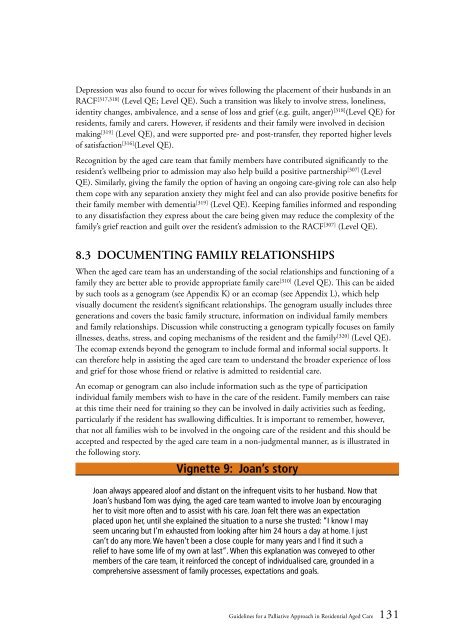Guidelines for a Palliative Approach in Residential Aged Care
Guidelines for a Palliative Approach in Residential Aged Care
Guidelines for a Palliative Approach in Residential Aged Care
You also want an ePaper? Increase the reach of your titles
YUMPU automatically turns print PDFs into web optimized ePapers that Google loves.
Depression was also found to occur <strong>for</strong> wives follow<strong>in</strong>g the placement of their husbands <strong>in</strong> an<br />
RACF [317,318] (Level QE; Level QE). Such a transition was likely to <strong>in</strong>volve stress, lonel<strong>in</strong>ess,<br />
identity changes, ambivalence, and a sense of loss and grief (e.g. guilt, anger) [318] (Level QE) <strong>for</strong><br />
residents, family and carers. However, if residents and their family were <strong>in</strong>volved <strong>in</strong> decision<br />
mak<strong>in</strong>g [319] (Level QE), and were supported pre- and post-transfer, they reported higher levels<br />
of satisfaction [316] (Level QE).<br />
Recognition by the aged care team that family members have contributed significantly to the<br />
resident’s wellbe<strong>in</strong>g prior to admission may also help build a positive partnership [307] (Level<br />
QE). Similarly, giv<strong>in</strong>g the family the option of hav<strong>in</strong>g an ongo<strong>in</strong>g care-giv<strong>in</strong>g role can also help<br />
them cope with any separation anxiety they might feel and can also provide positive benefits <strong>for</strong><br />
their family member with dementia [319] (Level QE). Keep<strong>in</strong>g families <strong>in</strong><strong>for</strong>med and respond<strong>in</strong>g<br />
to any dissatisfaction they express about the care be<strong>in</strong>g given may reduce the complexity of the<br />
family’s grief reaction and guilt over the resident’s admission to the RACF [307] (Level QE).<br />
8.3 DOCUMENTING FAMILY RELATIONSHIPS<br />
When the aged care team has an understand<strong>in</strong>g of the social relationships and function<strong>in</strong>g of a<br />
family they are better able to provide appropriate family care [310] (Level QE). This can be aided<br />
by such tools as a genogram (see Appendix K) or an ecomap (see Appendix L), which help<br />
visually document the resident’s significant relationships. The genogram usually <strong>in</strong>cludes three<br />
generations and covers the basic family structure, <strong>in</strong><strong>for</strong>mation on <strong>in</strong>dividual family members<br />
and family relationships. Discussion while construct<strong>in</strong>g a genogram typically focuses on family<br />
illnesses, deaths, stress, and cop<strong>in</strong>g mechanisms of the resident and the family [320] (Level QE).<br />
The ecomap extends beyond the genogram to <strong>in</strong>clude <strong>for</strong>mal and <strong>in</strong><strong>for</strong>mal social supports. It<br />
can there<strong>for</strong>e help <strong>in</strong> assist<strong>in</strong>g the aged care team to understand the broader experience of loss<br />
and grief <strong>for</strong> those whose friend or relative is admitted to residential care.<br />
An ecomap or genogram can also <strong>in</strong>clude <strong>in</strong><strong>for</strong>mation such as the type of participation<br />
<strong>in</strong>dividual family members wish to have <strong>in</strong> the care of the resident. Family members can raise<br />
at this time their need <strong>for</strong> tra<strong>in</strong><strong>in</strong>g so they can be <strong>in</strong>volved <strong>in</strong> daily activities such as feed<strong>in</strong>g,<br />
particularly if the resident has swallow<strong>in</strong>g difficulties. It is important to remember, however,<br />
that not all families wish to be <strong>in</strong>volved <strong>in</strong> the ongo<strong>in</strong>g care of the resident and this should be<br />
accepted and respected by the aged care team <strong>in</strong> a non-judgmental manner, as is illustrated <strong>in</strong><br />
the follow<strong>in</strong>g story.<br />
Vignette 9: Joan’s story<br />
Joan always appeared aloof and distant on the <strong>in</strong>frequent visits to her husband. Now that<br />
Joan’s husband Tom was dy<strong>in</strong>g, the aged care team wanted to <strong>in</strong>volve Joan by encourag<strong>in</strong>g<br />
her to visit more often and to assist with his care. Joan felt there was an expectation<br />
placed upon her, until she expla<strong>in</strong>ed the situation to a nurse she trusted: “I know I may<br />
seem uncar<strong>in</strong>g but I’m exhausted from look<strong>in</strong>g after him 24 hours a day at home. I just<br />
can’t do any more. We haven’t been a close couple <strong>for</strong> many years and I f<strong>in</strong>d it such a<br />
relief to have some life of my own at last”. When this explanation was conveyed to other<br />
members of the care team, it re<strong>in</strong><strong>for</strong>ced the concept of <strong>in</strong>dividualised care, grounded <strong>in</strong> a<br />
comprehensive assessment of family processes, expectations and goals.<br />
<strong>Guidel<strong>in</strong>es</strong> <strong>for</strong> a <strong>Palliative</strong> <strong>Approach</strong> <strong>in</strong> <strong>Residential</strong> <strong>Aged</strong> <strong>Care</strong> 131
















